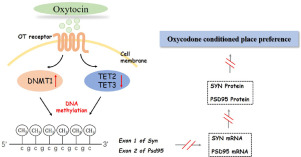当前位置:
X-MOL 学术
›
Eur. Neuropsychopharm.
›
论文详情
Our official English website, www.x-mol.net, welcomes your feedback! (Note: you will need to create a separate account there.)
Methylation in Syn and Psd95 genes underlie the inhibitory effect of oxytocin on oxycodone-induced conditioned place preference
European Neuropsychopharmacology ( IF 5.6 ) Pub Date : 2019-12-01 , DOI: 10.1016/j.euroneuro.2019.10.010 Xin-Yu Fan 1 , Guang Shi 2 , Ping Zhao 1
European Neuropsychopharmacology ( IF 5.6 ) Pub Date : 2019-12-01 , DOI: 10.1016/j.euroneuro.2019.10.010 Xin-Yu Fan 1 , Guang Shi 2 , Ping Zhao 1
Affiliation

|
Oxycodone (Oxy) is one of the most effective analgesics in medicine, but is associated with the development of dependence. Recent studies demonstrating epigenetic changes in the brain after exposure to opiates have provided an insight into possible mechanisms underlying addiction. Oxytocin (OT), an endogenous neuropeptide well known for preventing drug abuse, is a promising pharmacotherapy to counteract addiction. Therefore, we explored the mechanism of Oxy addiction and the role of OT in Oxy-induced epigenetic alterations. In this study, drug-induced changes in conditioned place preference (CPP), i.e. the expression of synaptic proteins and synaptic density in the ventral tegmental area (VTA) were measured. We also sought to identify DNA methyltransferases (DNMTs), ten-eleven translocations (TETs), global 5-methylcytosine (5-mC), and DNA methylation of two genes implicated in plasticity (Synaptophysin, Syn; Post-synaptic density protein 95, Psd95). Oxy (3.0 mg/kg, i.p.) induced CPP acquisition in Sprague-Dawley rats. Oxy down-regulated DNMT1 and up-regulated TET1-3, leading to a decrease in global 5-mC levels and differential demethylation at exon 1 of Syn and exon 2 of Psd95. These changes in DNA methylation of Syn and Psd95 elevated the expression of synaptic proteins (SYN, PSD95) and synaptic density in the VTA. Pretreatment with OT (2.5 µg, i.c.v.) via its receptor specifically blocked Oxy CPP, normalized synaptic density, and regulated DNMT1 and TET2-3 causing reverse of DNA demethylation of Syn and Psd95. DNA methylation is an important gene regulation mechanism underlying Oxy CPP, and OT - via its receptor - could specifically inhibit Oxy addiction.
中文翻译:

Syn 和 Psd95 基因中的甲基化是催产素对羟考酮诱导的条件性位置偏好抑制作用的基础
羟考酮 (Oxy) 是医学中最有效的镇痛剂之一,但与依赖性的发展有关。最近的研究表明,暴露于阿片类药物后大脑中的表观遗传变化为成瘾的可能机制提供了见解。催产素 (OT) 是一种众所周知的内源性神经肽,以防止药物滥用而闻名,是一种很有前途的药物治疗药物来对抗成瘾。因此,我们探索了 Oxy 成瘾的机制和 OT 在 Oxy 诱导的表观遗传改变中的作用。在这项研究中,药物诱导的条件性位置偏好 (CPP) 变化,即腹侧被盖区 (VTA) 中突触蛋白的表达和突触密度进行了测量。我们还试图鉴定 DNA 甲基转移酶 (DNMT)、十一个十一易位 (TET)、全局 5-甲基胞嘧啶 (5-mC)、和两个与可塑性有关的基因的 DNA 甲基化(突触素,Syn;突触后密度蛋白 95,Psd95)。Oxy (3.0 mg/kg, ip) 在 Sprague-Dawley 大鼠中诱导 CPP 获得。Oxy 下调 DNMT1 和上调 TET1-3,导致全球 5-mC 水平降低以及 Syn 外显子 1 和 Psd95 外显子 2 的差异去甲基化。Syn 和 Psd95 DNA 甲基化的这些变化提高了 VTA 中突触蛋白(SYN、PSD95)的表达和突触密度。用 OT(2.5 µg,icv)通过其受体进行预处理,特异性阻断 Oxy CPP,标准化突触密度,并调节 DNMT1 和 TET2-3,导致 Syn 和 Psd95 的 DNA 去甲基化逆转。DNA 甲基化是 Oxy CPP 的重要基因调控机制,OT - 通过其受体 - 可以特异性抑制 Oxy 成瘾。
更新日期:2019-12-01
中文翻译:

Syn 和 Psd95 基因中的甲基化是催产素对羟考酮诱导的条件性位置偏好抑制作用的基础
羟考酮 (Oxy) 是医学中最有效的镇痛剂之一,但与依赖性的发展有关。最近的研究表明,暴露于阿片类药物后大脑中的表观遗传变化为成瘾的可能机制提供了见解。催产素 (OT) 是一种众所周知的内源性神经肽,以防止药物滥用而闻名,是一种很有前途的药物治疗药物来对抗成瘾。因此,我们探索了 Oxy 成瘾的机制和 OT 在 Oxy 诱导的表观遗传改变中的作用。在这项研究中,药物诱导的条件性位置偏好 (CPP) 变化,即腹侧被盖区 (VTA) 中突触蛋白的表达和突触密度进行了测量。我们还试图鉴定 DNA 甲基转移酶 (DNMT)、十一个十一易位 (TET)、全局 5-甲基胞嘧啶 (5-mC)、和两个与可塑性有关的基因的 DNA 甲基化(突触素,Syn;突触后密度蛋白 95,Psd95)。Oxy (3.0 mg/kg, ip) 在 Sprague-Dawley 大鼠中诱导 CPP 获得。Oxy 下调 DNMT1 和上调 TET1-3,导致全球 5-mC 水平降低以及 Syn 外显子 1 和 Psd95 外显子 2 的差异去甲基化。Syn 和 Psd95 DNA 甲基化的这些变化提高了 VTA 中突触蛋白(SYN、PSD95)的表达和突触密度。用 OT(2.5 µg,icv)通过其受体进行预处理,特异性阻断 Oxy CPP,标准化突触密度,并调节 DNMT1 和 TET2-3,导致 Syn 和 Psd95 的 DNA 去甲基化逆转。DNA 甲基化是 Oxy CPP 的重要基因调控机制,OT - 通过其受体 - 可以特异性抑制 Oxy 成瘾。


























 京公网安备 11010802027423号
京公网安备 11010802027423号